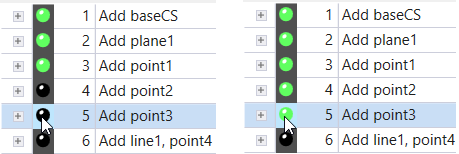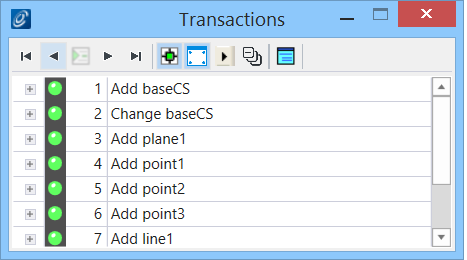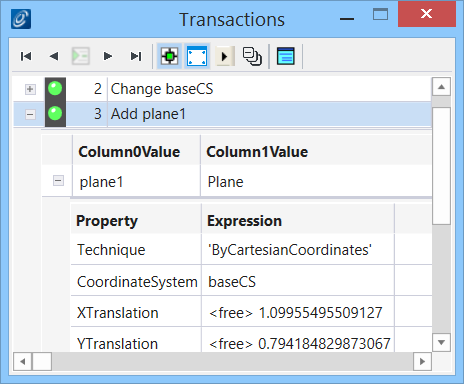| Transaction
|
transaction step appears in the Transaction dialog
as follows.

The
Transaction dialog shows an overview of the existing transaction steps.
When expanded, the expression statements recorded under each
transaction step are seen.
|
| Transaction controls
|
The
icon color of transaction step indicates its status:
-
 — Transaction being played, will
be visible in both geometry and graph views. — Transaction being played, will
be visible in both geometry and graph views.
-
 — Transaction being unplayed,
will vanish from both geometry and graph views. — Transaction being unplayed,
will vanish from both geometry and graph views.
-
 — Transaction being suppressed,
will vanish from view and the transaction step turns grey. — Transaction being suppressed,
will vanish from view and the transaction step turns grey.
At the bottom of the Transaction dialog are the controls for
moving backward and forward through the transaction steps.

Controls from
left to right:
-
 (Unplay all
transactions) — Allows you to undo all steps in the sequence of stored
transactions. (Unplay all
transactions) — Allows you to undo all steps in the sequence of stored
transactions.
-
 (Unplay the previous
transaction) — Allows you to undo the last played step in the sequence of
stored transactions. (Unplay the previous
transaction) — Allows you to undo the last played step in the sequence of
stored transactions.
-
 (Record recent model
changes as a new transaction) — Creates a new transaction step containing all
of the changes and new nodes since the last transaction step, named according
to the actions taken since the last transaction step. Clicking the text allows
you edit the name of the transaction step with any description that helps to
identify the specific step when revisiting the file. This allows you to
structure and name the sequences of steps used to create a particular model. (Record recent model
changes as a new transaction) — Creates a new transaction step containing all
of the changes and new nodes since the last transaction step, named according
to the actions taken since the last transaction step. Clicking the text allows
you edit the name of the transaction step with any description that helps to
identify the specific step when revisiting the file. This allows you to
structure and name the sequences of steps used to create a particular model.
-
 (Play the next
transaction) — Allows you to execute the next unplayed step in the sequence of
stored transactions. (Play the next
transaction) — Allows you to execute the next unplayed step in the sequence of
stored transactions.
-
 (Play all remaining
transactions) — Allows you to execute the remaining steps in the sequence of
stored transactions. (Play all remaining
transactions) — Allows you to execute the remaining steps in the sequence of
stored transactions.
-
 (Auto record a new
transaction whenever the model changes) — Allows recording of changes made in
the model as a new transaction step added in the list. (Auto record a new
transaction whenever the model changes) — Allows recording of changes made in
the model as a new transaction step added in the list.
 (Re-fit all views
whenever transactions are played) — Re-frames the Graph window and View window
every time a transaction step is played. (Re-fit all views
whenever transactions are played) — Re-frames the Graph window and View window
every time a transaction step is played.
 (Select all played
transactions) — Highlights all transactions in the list played in recent
session. (Select all played
transactions) — Highlights all transactions in the list played in recent
session.
 (Collapse all) — Collapse all
transaction steps including expanded expression statements within each to a top
level transactions. (Collapse all) — Collapse all
transaction steps including expanded expression statements within each to a top
level transactions.
 (Edit this entire
transaction list) — Opens a Script Editor window that allows you to edit all
transactions in the directory. (Edit this entire
transaction list) — Opens a Script Editor window that allows you to edit all
transactions in the directory.
Transaction steps can also be played or unplayed random by
clicking on their icon.

Play
transaction / Unplay Transaction
Note that irrespective of the current position of the cursor
in transaction steps list,
- (when clicked on
 ) – the unplayed
transactions above it are played, and ) – the unplayed
transactions above it are played, and
- (when clicked on
 ) – the played
transaaction below it are unplayed. ) – the played
transaaction below it are unplayed.
|
| Right-click a transaction
|
Right-clicking a transaction opens the following
choices:
Note: You can most
of the below options on multiple consecutive steps by selecting them while
pressing the <Ctrl> or <Shift> key.
- Edit
Transaction — Opens a Script Editor window that allows you to edit
a transaction.
-
Consolidate Transactions — Combines
continuous transactions.

Consolidate multiple
(consecutive) transactions
-
Suppress Transaction —
Suppresses one or more transactions without deleting the transaction step. The
transaction icon turns grey and corresponding nodes disappear from view if were
in play state.
-
Rebuild Transaction — Replaces the
selected transaction(s) with an alternative transaction(s) that achieve the
same result.
Note: The new
transaction(s) may add or change multiple nodes if those nodes are of the same
type. This operation cannot be undone.
- Split
Transaction — Replaces the selected transaction(s) with an
alternative transaction(s) that achieve the same result.
Note: The new
transaction(s) add or change only one node unless there is a recursive
relationship. This operation cannot be undone.
-
Unsuppress Transactions — Unsuppresses previously suppressed
transactions. The unsuppressed transactions reappear in unplay state.
- New
Include-File Transaction -— Opens a Script Editor window that
allows you to edit (Insert Before or
Insert After the selected transaction)
a transaction with the title "New Include-File Transaction".
- New
Model-Change Transaction — Opens a
Script Editor
window that allows you to edit (Insert
Before or
Insert After the selected transaction)
a transaction with the title "New Model-Change Transaction".
-
New Script Transaction — Opens a
Script Editor window that allows you to edit (Insert
Before or
Insert After the selected transaction)
a transaction with the title "New Script Transaction". The Script Editor begun
the script with heading:
transaction script 'New script transaction'
.
-
Delete Transaction — Deletes the
selected transaction.
- Cut
Transaction — Cuts the selected transaction. The transaction can be
pasted to another location in the transactions window.
- Copy
Transaction — Copies the selected transaction. The transaction can
be pasted to another location in the transactions window.
- Paste
Transactions — Pastes the transaction above
(Insert Before) or after
(Insert After) the selected transaction. This option can
also replace the selected transaction (Replace Transaction). Available only
when you cut or copy a transaction from the Transactions dialog.
|
| Right-click a statement
|
Expanding a step lists the statements.
Right-clicking a node statement opens the following choices:

-
Edit Statement - Opens a
Script Editor window with selected
node's statement code to edit.
For example,
node nodeName Bentley.GC.NodeTypes.Point
{
}
for a new node having default name
nodeName and type
Point. The statements defined in the script
with in the curly brackets would form the Property and Expression in the
statement.
-
Add Node Definition/Update Statement —
Adds new node definition with default name
nodeName and type that the host node.
- Add Node
Deletion Statement — Adds a delete statement
<--DELETE in the Node Type field of the
selected node definition.
- Delete
Statement(s) — Removes the selected node statement from the node
definition list.
- Copy
Statement(s) — Copies the statement in clipboard; the selected
statement can be used to paste.
-
Paste Statement(s) -> Add — Pastes
the copied statement in the statement list.
Add amends the statement in the end of
node definition list.
-
Paste Statement(s) -> Replace
— Replaces currently selected (cursor position in
the row) statement with the one from clipboard.
|
 Opens the
Transactions dialog which contains controls
for recording
transactions used to construct geometric and
associative content.
Opens the
Transactions dialog which contains controls
for recording
transactions used to construct geometric and
associative content.







 — Transaction being played, will
be visible in both geometry and graph views.
— Transaction being played, will
be visible in both geometry and graph views.
 — Transaction being unplayed,
will vanish from both geometry and graph views.
— Transaction being unplayed,
will vanish from both geometry and graph views.
 — Transaction being suppressed,
will vanish from view and the transaction step turns grey.
— Transaction being suppressed,
will vanish from view and the transaction step turns grey.

 — steps into nested transaction
file, by opening the included file in the transaction player and allows you to
edit the transaction steps of the external file.
— steps into nested transaction
file, by opening the included file in the transaction player and allows you to
edit the transaction steps of the external file.
 — unplays all the transactions
followed by returning to the outer-level host transaction.
— unplays all the transactions
followed by returning to the outer-level host transaction.
 — plays all transactions in the
included file and then returns to the outer-level host transaction.
— plays all transactions in the
included file and then returns to the outer-level host transaction.
